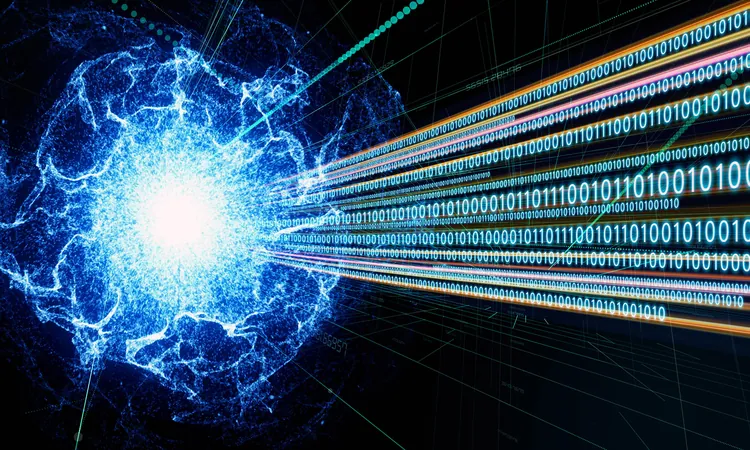
Mind-Boggling Breakthrough: Quantum Teleportation Achieved on Regular Internet Cables!
2024-12-31
Author: Lok
What is Quantum Teleportation?
At the heart of this achievement lies the concept of quantum teleportation—an extraordinary process in which the state of a particle (like a photon) is transmitted to another particle at a distance without the initial particle physically moving. By leveraging entangled photons, the researchers showcased a method that enables instantaneous, secure data sharing that holds great promise for future quantum networks.
The Science Behind the Achievement
The Northwestern team's innovative approach involved a setup that allows quantum information to navigate through the significant volume of regular internet traffic without interference. This breakthrough removes one of the largest barriers to making quantum networks a viable reality outside of laboratory settings.
Leading the research, Professor Prem Kumar, an esteemed figure in the field of electrical and computer engineering, believes this discovery reshapes the landscape of quantum and classical networks. "This is incredibly exciting because nobody thought it was possible," said Kumar. "Our work demonstrates a clear path towards integrating quantum communications into existing fiber optic infrastructures."
The Importance of Entanglement
The significance of quantum teleportation stems from its reliance on quantum entanglement, a phenomenon where two entangled particles are uniquely linked—changes to one instantaneously affect the other, regardless of the distance separating them. This connection allows information to be shared almost instantly—that is, nearly at the speed of light—in a manner that ensures security against interception and eavesdropping.
Overcoming Challenges
In the past, achieving quantum teleportation typically required pristine, controlled environments. Many researchers assumed that real-world cables, engulfed in a noise of signals, would drown out delicate quantum information. However, the Northwestern team's tests demonstrated otherwise; they managed to send both quantum signals and classical communications over the same fiber optic cable without any interference.
By fine-tuning specific wavelengths and implementing specialized filters, the researchers were able to secure a path for single photons amid the clutter of regular internet data.
Future Prospects for Quantum Networking
The research team is gearing up to scale their successful method to longer cable runs, eventually seeking to integrate it with underground fiber networks. They also plan to explore the possibilities of using multiple pairs of entangled photons, a vital step known as entanglement swapping, which could facilitate the development of expansive quantum networks across various regions.
Imagine the implications of such networks for industries requiring utmost security, like finance, defense, and data management, all of which could benefit from quantum methods—where any attempt at tampering is immediately detectable.
Unlocking New Applications
This breakthrough not only enhances the feasibility of quantum communications but also opens the door to numerous applications, including distributed quantum computing, advanced sensing technologies, and even innovations in encryption and fundamental physics experiments. The ability to synchronize distant clocks or share cryptographic keys with unprecedented security could redefine the standards of information exchange.
A Future Interwoven with Quantum Technology
Quantum teleportation—a concept that once seemed confined to theoretical discussions—has now begun its transition into a practical tool. The prospect of integrating fragile quantum signals into existing communication frameworks lowers the entrance barrier for industries looking to leverage quantum technology without the massive costs associated with dedicated fiber networks.
As research progresses, the promise of a coexistence between classical and quantum information streams appears more achievable than ever. The vision of a future where these networks operate harmoniously is on the horizon, with potential implications that could transform how we communicate and process information.
This remarkable study has been published in the journal Optica, marking a significant milestone in the quest for more efficient and secure communication technologies.




 Brasil (PT)
Brasil (PT)
 Canada (EN)
Canada (EN)
 Chile (ES)
Chile (ES)
 Česko (CS)
Česko (CS)
 대한민국 (KO)
대한민국 (KO)
 España (ES)
España (ES)
 France (FR)
France (FR)
 Hong Kong (EN)
Hong Kong (EN)
 Italia (IT)
Italia (IT)
 日本 (JA)
日本 (JA)
 Magyarország (HU)
Magyarország (HU)
 Norge (NO)
Norge (NO)
 Polska (PL)
Polska (PL)
 Schweiz (DE)
Schweiz (DE)
 Singapore (EN)
Singapore (EN)
 Sverige (SV)
Sverige (SV)
 Suomi (FI)
Suomi (FI)
 Türkiye (TR)
Türkiye (TR)
 الإمارات العربية المتحدة (AR)
الإمارات العربية المتحدة (AR)